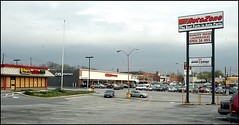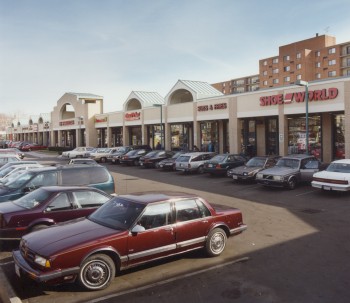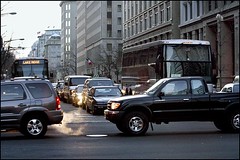City Business as usual--land giveaways, diminishing urban design
Today's Washington Post has an article about the Skyland development in Ward 7.
 (Photo from the Washington Post.) This is a controversial project for a number of reasons because it:
(Photo from the Washington Post.) This is a controversial project for a number of reasons because it:1. Proposes to tear down a successful, albeit "tired" commercial development;
2. through land assemblage, if necessary through eminent domain, by a government agency, the National Capital Revitalization Corporation (this has been written about a lot by Tom Knott in the Washington Times, as well as in the Post, and I have written about this elsewhere);
3. which will then give the land at a steep discount to a predominately suburban but well-connected developer, Gary Rappaport, who is a past chairman of the trade group of developers and shopping center owners, the International Council of Shopping Centers;
4. Because he claims he will bring national chains like Target to the retail underserved Ward 7;
5. In a shopping center design that is likely to be automobile-centric, parking fronted, and anti-urban**;
6. In a city, Washington, DC, that has a great tradition of urban, pedestrian-oriented design.
 H Street Connection, developed in the mid-1980s with financial support from the DC Department of Housing and Community Development, via monies from the federal Department of Housing and Urban Development. Rappaport paid $500,000 for the property. This parking lot is normally filthy, clearly this is an old photo. **On Thursday night at a Zoning Commission hearing about a Neighborhood Commercial District zoning overlay for H Street NE, which among its provisions would impose design requirements including disallowing parking-fronted construction, the zoning lawyer representing the Rappaport Companies called such urban design requirements an unreasonable restriction of developer rights and anti-market.
H Street Connection, developed in the mid-1980s with financial support from the DC Department of Housing and Community Development, via monies from the federal Department of Housing and Urban Development. Rappaport paid $500,000 for the property. This parking lot is normally filthy, clearly this is an old photo. **On Thursday night at a Zoning Commission hearing about a Neighborhood Commercial District zoning overlay for H Street NE, which among its provisions would impose design requirements including disallowing parking-fronted construction, the zoning lawyer representing the Rappaport Companies called such urban design requirements an unreasonable restriction of developer rights and anti-market.The article has two sentences that screamed out to me:
"The National Capital Revitalization Corp. agreed to pay $2.39 million for a two-acre parcel that houses a postal sorting facility. The land is owned by an affiliate of the Anacostia Economic Development Corp., which bought it for $1.1 million in 2001 but did not develop it. " This is pretty typical, local community development corporations mothball land and reap great profits for doing nothing.
and
"City officials have talked for years about buying the 18.5-acre site at the confluence of Alabama Avenue and Good Hope and Naylor roads SE and creating a suburban-style complex that would include national retailers and at least one sit-down restaurant."
You'd think that after the design fiasco of the Brentwood Shopping Center that City economic development officials would "Get Urban" and begin to remember that the city is urban, and adopt policies to extend and strengthen urban design through new projects, rather than diminishing the urban fabric through projects that promote automobility.
One way to do this is to make the project mixed use, and to build up not just out, providing housing above the normally unused "air rights" (note that the Wax Museum development project in the Mt. Vernon Triangle Area of the city is a multi-story mixed use condominium project that will include a Safeway and other retail on the ground floor), and look more carefully at other development aspects, consider adding public facilities (certainly this should be encouraged considering the developer will acquire the property for millions of dollars less than what NCRC will ultimately pay for it) such as libraries and making provisions for the support and development of independently-owned and operated retail, which ultimately will have greater returns for the local economy.
While I constantly argue "in favor of congestion" because congestion on city streets in some respects is a sign of economic health and vitality, on the other hand, creating congestion by developing projects that promote autocentricity, bringing more and more cars on the streets, does not serve the future of the city.
 Rather than making over all quadrants of the city in favor of the car, new residents to the city need to adopt and adapt to city living, rather than impose suburbanity. (Photo from the Washington Post.)
Rather than making over all quadrants of the city in favor of the car, new residents to the city need to adopt and adapt to city living, rather than impose suburbanity. (Photo from the Washington Post.)



0 Comments:
Post a Comment
<< Home